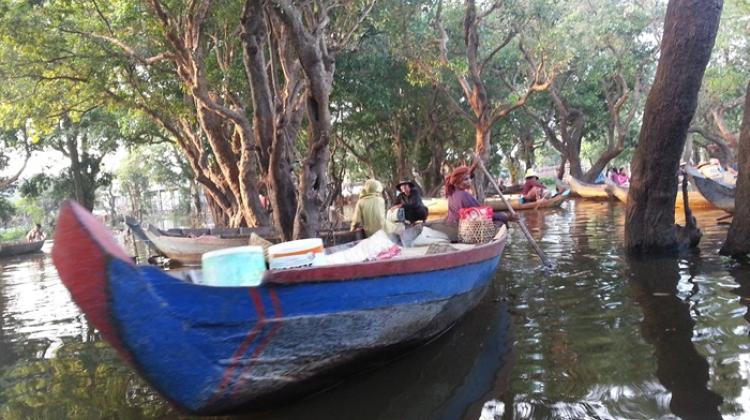Biodiversity changes in Asia are far-reaching and often beyond control
 Transport of fish after fishing on Tonle Sap Lake, Cambodia (the lake is overfished and losing species diversity). 2014. Credit: A.Afelt
Transport of fish after fishing on Tonle Sap Lake, Cambodia (the lake is overfished and losing species diversity). 2014. Credit: A.Afelt
In Southeast Asia, population growth and the demand for agricultural land are causing significant changes in biodiversity, resulting in an increasing epidemiological risk. This risk concerns viruses such as coronaviruses, bird flu virus, MERS, USUTU, Zika, dengue and malaria, says Dr. Aneta Afelt from the University of Warsaw.
Biodiversity - according to the European Environment Agency - is a concept collectively describing the variety of life and includes all living organisms found on Earth, as well as the interactions between them. 'Yet despite biodiversity's intrinsic value and its fundamental importance for humans, biodiversity is highly threatened by human activities and continues to be lost,' says the agency's website. The five key anthropogenic drivers of biodiversity loss are habitat loss (e.g. deforestation, intensive monoculture practices, urbanization), overexploitation of natural resources (such as hunting and overfishing), climate change, pollution and invasive alien species
Dr. Afelt from the Interdisciplinary Centre for Mathematical and Computational Modelling at the University of Warsaw, an expert dealing with the relationship between the rate of transformation of the natural environment and epidemiological risk, says that Southeast Asia is 'one of the so-called sanctuaries of global biodiversity'. The region consists of a large area of continental Asia and several thousand islands, from small archipelagos to islands such as Sumatra or Borneo, with areas exceeding those of European countries.
GALLOPING DEMOGRAPHICAL DEVELOPMENT AND AGRICULTURAL PRODUCTION
In Asia, we face two main pressures on biodiversity. 'The first is rapid demographic development while maintaining fertility rates - these are the so-called young communities, i.e. those with a low average age of the population,’ says Afelt, an expert in health geography and physical geography.
The second derivative factor, according to Afelt, is the territorial pressure related to food production to meet local needs, but above all for export purposes. 'It is very often agricultural production with typical features of industrial production, in a dispersed ownership system,’ she says. She adds that 'this means that there are many owners of relatively small areas of cultivation, striving to maximize profits.’
Afelt says that it is typical to introduce activities that increase yields and protect crops against natural losses. But she adds 'there is widespread use of pesticides, many of which have been withdrawn from the market for years in Europe due to their degrading impact on the natural environment.
'On the one hand, the population explosion necessitates the need to expand into new agricultural areas. On the other hand, the development of the plantation economy has been observed for many years - such as palm or rubber plantations. From a biological point of view, this means the complete removal of the current biotope and replacing it with planned agricultural development'.
RAPID DEVELOPMENT OF URBAN AREAS
In Asia, there is a mass migration of people from overpopulated agricultural areas to urban zones. This results in rapid development of urbanized areas.
'The spatial sprawl of cities is a very fast process here,’ says Afelt. She adds that this has a degrading effect on natural resources 'but more importantly - these processes are poorly structured, and the development of urban infrastructure and spatial planning in many countries is quite arbitrary.’
Meanwhile, preserving biodiversity is crucial, not only because of its value in itself - but also because it provides us with clean air and water, high-quality soil and pollination of crops. It helps slow down and adapt to climate change and helps reduce the impact of natural hazards. Therefore, its decline has serious consequences for society, the economy and human health.
WILD ANIMALS CLOSER AND CLOSER TO HUMAN SETTLEMENTS
Over the last 50 years or so, Asia has seen large-scale changes in land cover and land use throughout the region. Afelt says: ‘The main changes include massive clearing of tropical and subtropical forests.
'Mechanical removal of trees and all accompanying plant cover results in the loss of life for a huge number of animal species, which unfortunately most often do not have a chance to adapt to new conditions.
‘Many species try to adapt in the immediate vicinity of human settlements, which, firstly, is not always desirable (most often it is not), and secondly, it is a potential cause of threat to the physical and health safety of people and farm animals.’
Field research, in which Dr. Afelt participated in 2014-2016, concerning the transmission of coronaviruses by bats in Cambodia and Laos, indicated a tendency of infected bats to migrate closer to human settlements as a consequence of massive deforestation.

In her opinion, it is important that due to these migrations, bat species that are separated from each other in natural conditions, exist next to each other in the new places. 'Consequently, the immediate proximity of many species of bats, farm animals, pets and people creates an ideal environment for accelerated circulation of pathogens and causes a high epidemiological risk,’ Afelt tells PAP - Science in Poland.
BIODIVERSITY CHANGES OUT OF CONTROL
'The process of rapid demographic growth in Southeast Asia, combined with the demand for agricultural land, is the cause of far-reaching and often uncontrollable changes in biodiversity, including changes resulting in a growing epidemiological risk', she points out. 'This is the story of SARS-COV-2, and bird flu, and MERS, and USUTU, but also malaria...'.
Why are these changes out of control? The expert explains that there are huge economic differences in the social structure in Southeast Asian countries. 'The dominant part of local communities are people on the verge of poverty in European terms,’ replies Afelt. In her opinion, economic disparities and the educational opportunities associated with them make it difficult to transfer knowledge and technology down the social pyramid. 'On the other hand, the countries of this region are included in the group of dynamically developing economic countries with a growing need to change their social status. Hence, there is a very high demand for highly desirable consumer goods, which are already saturated in our market,’ says Afelt.
She believes that universal access to the Internet and the ability to observe 'what life is ‘like" in highly developed countries is one of the factors driving demand. 'The demand for consumer goods seems to be a higher priority than... the protection of natural resources. A similar situation also occurred in our region of the world not so long ago,’ she says.
In these conditions, it is very difficult to implement restrictive policies at the country level, e.g. spatial order or protection of natural environmental resources. 'If we look at the problem from a global perspective, it is easy to see an analogy: the higher the level of economic development and education in countries, the greater the care for the quality of living conditions, taking into account natural resources,’ Afelt continues.
She also points out that the impact of the decline in biodiversity on the epidemiological threat is not a simple cause and effect relationship. 'We still have many cognitive gaps in the process of natural circulation of pathogens, interspecies breakthroughs, proverbial +plot twists+, very often resulting from insufficient knowledge,’ she says.
Afelt adds that we are far from achieving full knowledge about viruses, bacteria and parasites circulating in the environment. 'We know as much as we have learnt. And in the world there are still so-called sanctuaries, civilizationally untouched refuges of an untransformed environment, which are poorly explored, for example in Papua,’ she says.
The research conducted by Dr. Afelt is an example of a research approach called Planetary Health, EcoHealth or One Health, which focuses on the human-environment-health relationship, pointing to the multidirectional interdependence between our health and the prospect of maintaining or improving it - and the planet's resources, their availability , quality and degradation/restoration.
'Contrary to appearances, these two substantively distant areas (transformation of the natural environment and epidemiological risk - PAP) are in a direct cause-and-effect relationship,’ Afelt says. (PAP)
PAP - Science in Poland, Anna Mikołajczyk-Kłębek
amk/ zan/ kap/
tr. RL
Przed dodaniem komentarza prosimy o zapoznanie z Regulaminem forum serwisu Nauka w Polsce.
















